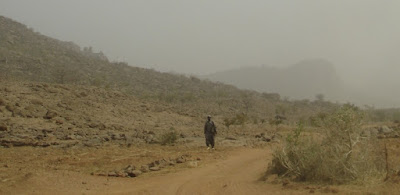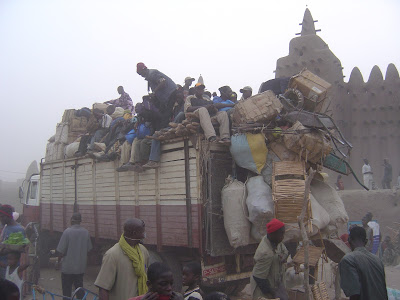Friday 23 March 2007
Limping into Timbuktu
The piste runs directly north of Douentza to Timbuktu, 200km away. It weaves through an undulating Sahel landscape of acacia bushland, sand and close cropped grasslands. The surface has heavy corrugations, an effect created by the passing of vehicles over time. These literally shake a car to bits, and the wayside is littered with parts of exhausts. It is possible to get relief from the corrugations by driving on parallel sandy tracks, but these are also wearing, as you must keep up momentum to avoid getting stuck, and will inevitably hit a large hole and decide to try the main track again.
It was lucky we were not far from Timbuktu. We drove slowly on to the river crossing, having lunch by the bank as we waited for the ferry. We reversed up the ramp, followed by a horseman with a decorated saddle, bare feet in round metal stirrups.
There was only another 10km then to Timbuktu, and we limped in with great grinding and squeaking. We checked in at a hotel and gave them a pile of very dirty clothes and towels, showered, and went in search of repairs. The hotel called a mechanic, and he sat in and showed us the way through the maze of sandy streets. Along the way, the police gave us a hard time about having three people in two seats, which is a bit of a joke considering how they fill vehicles here. They also insisted we should visit the Customs for a laissez passer document, and register with the police, both of which I expect will be opportunities to make donations to local funds.
On the outskirts of town we parked under a tree amid a collection of vehicle wrecks, mechanics, apprentices, consultants and onlookers. With a handful of tools, they set to work, removing the steering rod and dispatching it to the forge for straightening. A couple of hours later, the car was driving better than ever.
Hitchhikers
Djenne and back to Pays Dogon
This blog is the diary of a journey through the Sahara undertaken February-May 2007. The most recent post is first.
-
Agadir is Morocco's Costa del Sol , in other words the fifth circle of hell. The best that can be said is that we enjoyed our first beer...
-
The Algerian border post - we camped on their football pitch Lots of this en route Con and Haakon are wondering how this chap was changi...
-
The Mediterranean coast of Algeria is to be avoided for security reasons, and the central deserts are not as dramatic as those of the South,...





































